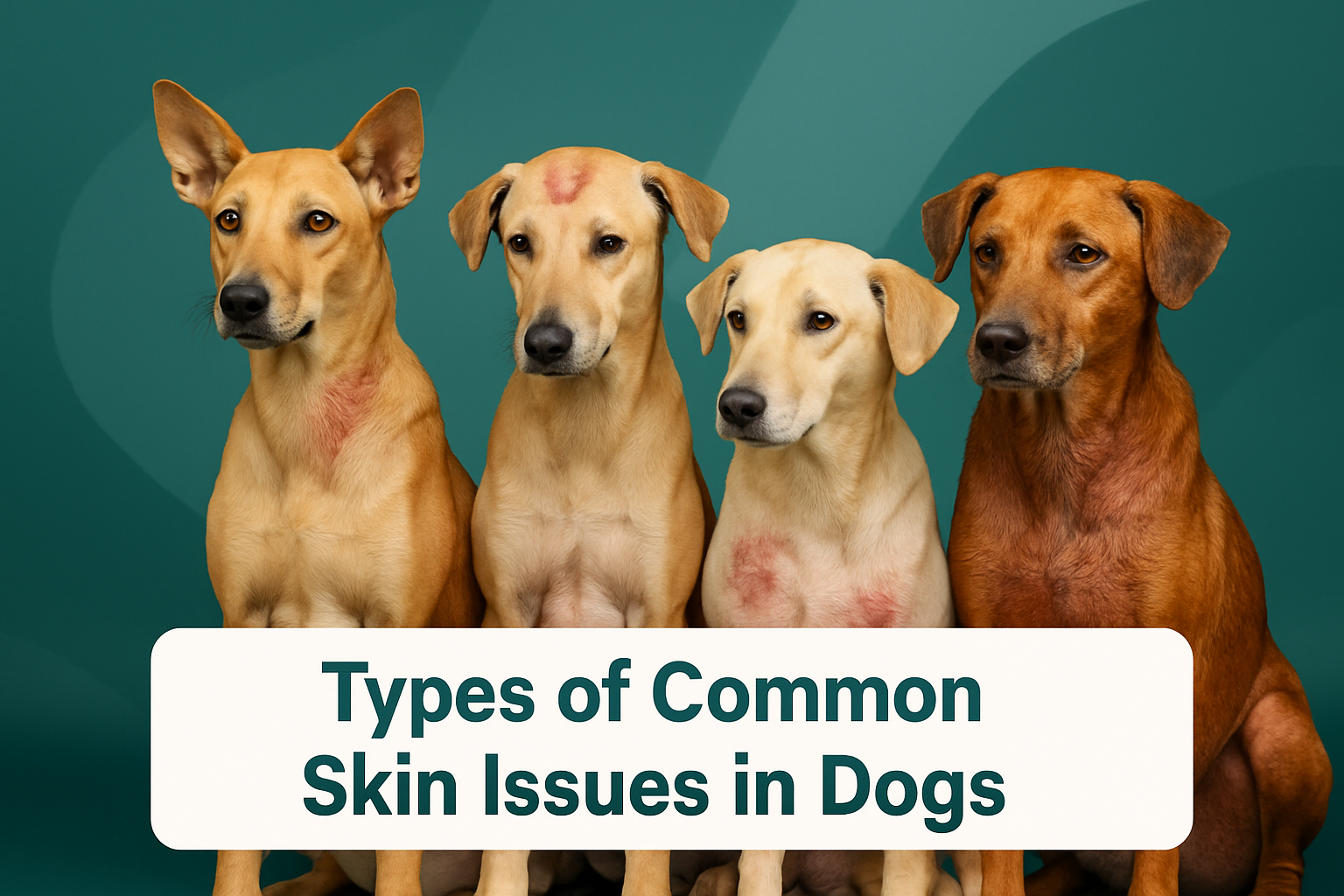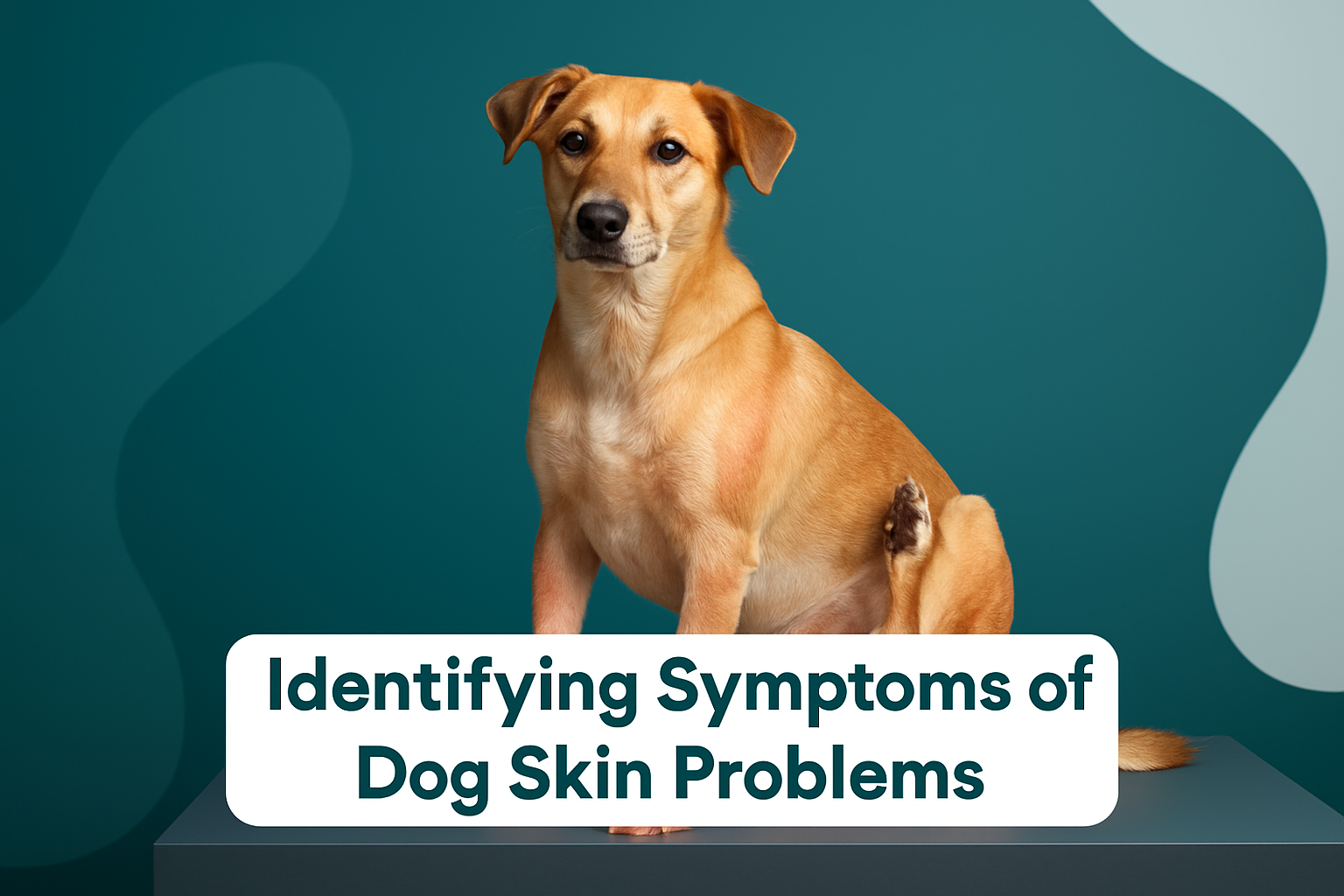A dog's skin tells tales of their overall health - when it's troubled, your furry companion suffers silently. Skin issues are among the most common health concerns for dogs in India, influenced by environmental factors, diet, and genetics. Understanding these conditions is crucial for early intervention.
Types of Common Skin Issues in Dogs

Did you know that nearly 1 in 3 dogs will experience some form of skin issue during their lifetime? Understanding the types of common skin issues in dogs can help pet parents identify problems early and seek appropriate treatment. Let's explore the primary skin conditions that affect our canine companions in India.
Allergic Dermatitis
Allergic reactions are among the most prevalent types of common skin issues in dogs across India. These reactions typically manifest as redness, itching, scratching, and inflammation. Environmental allergens like dust mites, pollen, and mold often trigger these responses, particularly during seasonal changes.
Food sensitivities represent another significant cause of allergic dermatitis. Proteins like chicken, beef, dairy, and certain grains can trigger immune responses in sensitive dogs. These allergies typically cause persistent itching, gastrointestinal upset, and recurrent ear infections alongside skin problems.
Seasonal triggers deserve special attention in the Indian climate, where monsoon and summer seasons bring unique challenges. Many dogs experience flare-ups during specific times of year, requiring vigilant monitoring and preventive care.
Fungal and Bacterial Infections
Hot spots (acute moist dermatitis) appear suddenly as red, moist, and painful lesions. These types of common skin issues in dogs develop when bacteria infect the skin, often following a minor irritation that the dog has licked or scratched excessively.
Yeast infections, particularly caused by Malassezia, thrive in warm, moist environments. These infections commonly affect the ears, paw pads, and skin folds, creating a distinctive musty odor and causing intense itching.
The humid Indian climate provides perfect conditions for these infections to spread rapidly. Dogs in coastal regions or areas with high humidity levels face greater risks, especially during monsoon season when moisture levels peak.
Parasitic Infestations
External parasites represent some of the most troublesome types of common skin issues in dogs. Ticks not only cause localized irritation but can transmit serious diseases like babesiosis and ehrlichiosis, prevalent in many parts of India.
Fleas cause intense itching and discomfort, with many dogs developing flea allergy dermatitis—an allergic reaction to flea saliva that causes severe inflammation and discomfort far beyond the actual bite sites.
Mites, including those causing demodex and sarcoptic mange, burrow into the skin creating patches of hair loss, crusty lesions, and severe itching. These parasites can significantly compromise skin health if left untreated, leading to secondary infections and chronic discomfort.
Identifying Symptoms of Dog Skin Problems

Early detection of skin problems in your dog can prevent discomfort and more serious health complications. Identifying symptoms of dog skin problems requires careful observation of both visible changes and behavioral cues. Regular check-ups during grooming sessions offer the perfect opportunity to spot potential issues before they escalate.
Visual Indicators
When identifying symptoms of dog skin problems, start by examining your pet's coat and skin thoroughly. Look for redness or inflammation, which often appears first in sensitive areas like the belly, paws, and ears. Rashes may manifest as clusters of small bumps or pimple-like spots, particularly in areas where fur is thinner. Scabs or crusty patches indicate more advanced skin irritation, possibly from scratching or infection.
Hair loss presents another crucial warning sign, whether appearing in patches or as general thinning. Pay close attention to changes in skin color—darkening may indicate chronic inflammation, while unusual pale areas could suggest fungal infections. Skin texture changes like thickening, flaking, or oiliness also warrant attention, as these can signal various underlying conditions from allergies to hormonal imbalances.
Behavioral Signs
Dogs experiencing skin discomfort communicate through specific behaviors. Excessive scratching, especially if focused on one area, represents the most obvious sign of irritation. Persistent licking or biting at certain body parts indicates your dog is trying to relieve discomfort. Many dogs with skin problems also rub against furniture, carpets, or walls in attempts to alleviate itchiness.
Watch for changes in your dog's demeanor as well. Skin problems often cause restlessness, irritability, or lethargy due to constant discomfort or disturbed sleep. Some dogs may even become sensitive to touch in affected areas, flinching or showing signs of pain when petted.
Secondary Complications
Untreated skin issues rarely resolve independently and frequently lead to more severe health problems. The skin's protective barrier, when compromised, allows bacteria to enter and cause secondary infections, characterized by odor, discharge, or increased pain. Chronic inflammation from persistent skin problems can trigger systemic effects, potentially impacting internal organs over time.
The psychological impact shouldn't be underestimated either. Dogs suffering from constant itching often experience stress, anxiety, and sleep disturbances, affecting their overall quality of life. Prompt identification of skin symptoms and appropriate veterinary care ensures your furry companion maintains both physical health and emotional wellbeing.
Natural and Holistic Approaches to Treatment

When addressing pet skin issues, Natural and Holistic Approaches to Treatment often provide gentle yet effective solutions without the side effects of harsh medications. These methods work by supporting your pet's overall health while directly addressing skin concerns through comprehensive care.
Dietary Interventions
A balanced diet forms the cornerstone of Natural and Holistic Approaches to Treatment for skin conditions. Nutrients like omega-3 fatty acids found in fish oil can significantly reduce inflammation and improve coat quality. Probiotics support gut health, which directly affects skin condition through the gut-skin axis.
Many skin issues stem from food sensitivities, making an elimination diet valuable for identifying problematic ingredients. Quality protein sources and antioxidant-rich foods help repair damaged skin cells and promote healing. Supplements containing zinc, vitamins A and E, and biotin can strengthen skin barriers and enhance recovery when diet alone isn't sufficient.
Topical Solutions
Natural topical remedies provide direct relief while aligning with holistic treatment philosophies. Aloe vera gel offers cooling anti-inflammatory benefits for irritated skin, while coconut oil provides antimicrobial protection and moisture retention. Oatmeal baths can soothe itching and inflammation without harsh chemicals that might worsen sensitivity.
Calendula and chamomile-based products reduce redness and promote healing through their gentle botanical properties. Apple cider vinegar dilutions (1:3 with water) help balance skin pH and fight yeast infections common in skin folds. When selecting products, choose options free from artificial fragrances, colors, and preservatives that might trigger reactions.
Environmental Management
Creating a clean living environment is an essential component of Natural and Holistic Approaches to Treatment. Regular washing of pet bedding in hot water using fragrance-free detergent eliminates dust mites and accumulated allergens. HEPA filters can dramatically reduce airborne irritants affecting sensitive pets.
Limiting exposure to potential irritants like household chemicals, synthetic carpeting, and certain fabrics can prevent flare-ups. Regular but gentle grooming removes environmental allergens before they penetrate the skin. For homes with multiple pets, maintaining separate sleeping areas can prevent cross-contamination of skin issues while supporting individual healing processes.
When to Seek Professional Veterinary Care
Knowing when to seek professional veterinary care for your pet's skin conditions can make the difference between minor discomfort and serious health complications. While some skin issues resolve with home care, others require medical intervention. Here's what every pet parent should know about professional care options.
Warning Signs That Indicate Immediate Veterinary Attention
Your pet's skin provides valuable clues about their overall health. When to seek professional veterinary care becomes clear when you notice certain red flags. Persistent scratching or licking that leads to hair loss or open wounds requires immediate attention. Rashes that spread quickly, unusual bumps or swellings, and skin that appears discolored (particularly yellow or purple tints) should trigger a vet visit.
Pay close attention if your pet shows signs of discomfort like whimpering when touched or reluctance to be handled. Severe flaking, crusting, or oozing from the skin are never normal and often signal infection. Remember that changes in behavior—like lethargy or loss of appetite—alongside skin issues often indicate that the problem extends beyond the skin surface.
Diagnostic Procedures Veterinarians Typically Use for Skin Conditions
When you seek professional veterinary care, your vet will likely employ several diagnostic techniques. The process typically begins with a thorough physical examination and detailed history of your pet's symptoms. Skin scrapings allow microscopic examination for parasites, while fungal cultures can identify infections like ringworm.
In more complex cases, your veterinarian might recommend blood tests to check for underlying conditions or allergies. Skin biopsies, though more invasive, provide definitive answers for persistent or serious skin disorders. Advanced imaging techniques may be used when deep skin infections or tumors are suspected. These diagnostic tools help veterinarians develop targeted treatment plans rather than simply addressing symptoms.
Benefits of Integrating Conventional Treatments with Holistic Wellness Approaches
Professional veterinary care doesn't have to mean choosing between conventional medicine and natural approaches. The most effective skin treatments often combine both strategies. Prescription medications can provide immediate relief from infections or inflammation, while holistic approaches support long-term skin health.
When to seek professional veterinary care includes considering practitioners who understand this integrated approach. High-quality supplements that support immune function and skin barrier health can complement medical treatments. Proper nutrition plays a fundamental role in skin recovery and maintenance. Veterinarians who consider the whole animal—including stress levels, environment, and diet—often achieve better outcomes for pets with chronic skin conditions.
Conclusion
Most dog skin issues can be effectively managed through proper nutrition, grooming, and environmental management. Prevention and early intervention are key to maintaining your pet's skin health.
Take the first step toward resolving your dog's skin issues with natural, vet-approved solutions designed specifically for Indian climates and breeds.




